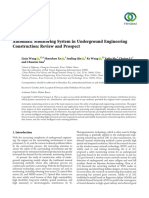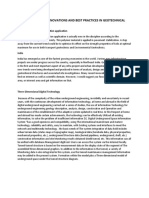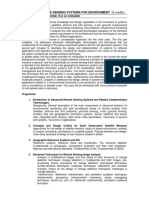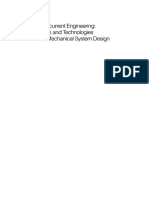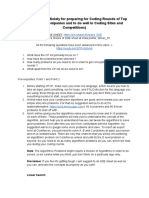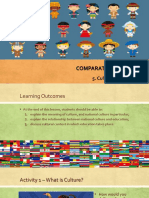Survey Disciplines Work Plan
Survey Disciplines Work Plan
Uploaded by
Charles O. GayaCopyright:
Available Formats
Survey Disciplines Work Plan
Survey Disciplines Work Plan
Uploaded by
Charles O. GayaOriginal Description:
Original Title
Copyright
Available Formats
Share this document
Did you find this document useful?
Is this content inappropriate?
Copyright:
Available Formats
Survey Disciplines Work Plan
Survey Disciplines Work Plan
Uploaded by
Charles O. GayaCopyright:
Available Formats
Appendix to item 17.
Commission 6 – Engineering Surveys
Work Plan 2011-2014
1. Title
Engineering Surveys.
2. Terms of Reference
Acquisition, processing and management of topometric data and all related information
throughout the life cycle of a project (at construction site)
Quality control and validation for civil engineering constructions and manufacturing of
large objects (method statements)
Modern concepts for setting-out and machine guidance
Deformation monitoring, analysis and interpretation, measurement of dynamic loaded
structures (general)
Prediction of deformation and movements in engineering projects, mines and areas of
geological hazard such as land slides, subsidence etc
Automatic measuring systems, construction and industry and multi-sensor measuring
systems
Terrestrial laser systems, their usage in architecture, civil engineering and industry
including automated periodic measurements in order to measure track movements
Industry measuring system metrology, testing and quality control
Standards related to the construction, deformation measurement and measuring system
metrology
3. Mission Statement
The mission of Commission 6 is to:
promote the knowledge, skills and abilities of surveyors in civil and industrial works
within the various professional fields of engineering
support all development and multidisciplinary expertise leading to integrated survey
methods, using various instruments (geodetic, geotechnic, fast motion) and sensors and
combining geometry with all other data relevant to each engineering problem
provide a forum for exchange of knowledge related to engineering analysis of survey data
for the study of structures
in addition to the links with related WGs of IAG, ISM and ISPRS, look for possible co-
operation within these organisations and support the co-operation of civil, structural and
mechanical engineers with our profession
participation with ICOLD (International Committee on Large Dams) national committees
participation on the FIG Standards Network on standardisation policy, support the
standardisation activities at the international, local and national level, and development of
standards and method statements
FIG 34th General Assembly 1/8
Marrakech, Morocco, 18-22 May 2011
FIG Commission 6 – Work Plan 2011-2014
participation on regional FIG events, and events organised in co-operation with sister
organisations.
4. General
This Working Plan covers a wide scale of survey disciplines related to plants, installations
and constructions of any kind. Commission 6 wants to promote:
development of international standards and qualifications,
development of best practice guides in Engineering Surveys,
Commission 6 will consist of three Working Groups and one joint working group with
Commission 5. Commission 6 has study groups on specific issues and these could also be
used for the FIG contribution to respond to global warming and disaster management.
The Council has requested Commission 6 to consider establishing a Memorandum of
Understanding with the Institution of Civil Engineers (ICE).
5. Working Groups
Working Group 6.1 – Deformation Measurements and Analysis
Policy Issues
Deformation studies in Engineering Surveying are based on a broad knowledge of suitable
sensors and their potential, modern data storage and communication solutions and advanced
processing and analysis methods. Additionally a thorough understanding of the behaviour of
monitoring objects (large scale structure or landslide effected area), is essential to set-up and
operate an optimum monitoring system. Nowadays deformation tasks are more and more
oriented towards real-time systems, which require automation of data capture and new
concepts in data processing, analysis and interpretation.
WG6.1’s main goals will be to support specialists in deformation studies with state-of-the art
solutions and provide latest developments and future oriented concepts:
Promoting studies on the potential of existing and new sensors to determine geometric
deformation quantities from surveying and adjacent fields such as geotechnics;
Promoting the development of concepts for automated data storage, data transfer and data
pre-processing;
Promoting the adaptation of numerical algorithms to derive relevant deformation
quantities in real-time, including concepts from time series analysis;
Promoting a multidisciplinary collaboration between surveying, structural and
geotechnical engineers to understand the behaviour of structures and geotechnical objects;
Study of most modern concepts for data analysis like artificial neural networks, fuzzy
logics and generic algorithms;
Initiate investigations to extend the range of deformation studies to higher frequencies,
which are important in Structural Health Monitoring, i.e. to be able to study oscillations
and vibrations and their effects on critical structures;
Chair
Prof. Dr. Wolfgang Niemeier (Germany), e-mail: w.niemeier@tu-bs.de
FIG 34th General Assembly 2/8
Marrakech, Morocco, 18-22 May 2011
FIG Commission 6 – Work Plan 2011-2014
Secretary:
Dr.-Ing. Björn Riedel (Germany), e-mail: b.riedel@tu-bs.de
Specific Projects
Prepare reports on State-of-the-Art for typical deformation tasks (e.g. dams, bridges, high
buildings, landslides, rock-fall, …);
Comparison of most modern instrumentation for automated deformation measurements;
Comparison of concepts from artificial intelligence for deformation analysis;
Case studies: For a typical data set of continuous observations, which has to be defined,
different analysis concepts and tools have to be applied.
Workshops/Symposia
14th International Symposium on Deformation Measurements, Hong Kong, Nov. 2011
15th International Symposium on Deformation Measurements, Europe (Hamburg ?), 2014
These symposia will continuously be organised as joint symposia with IAG/ WG 4.2,
Publications
Proceedings of the meetings (it is intended to have peer reviewed proceedings)
Beneficiaries
Surveying professionals dealing with all aspects of deformation studies
Surveyors interested in most modern, automated instrumentation
Geologists, structural and geotechnical engineers concerned with deformation tasks
Study Groups:
For each of the specific projects, given above, a study group could be initiated.
Working Group 6.2 – Engineering Surveys for Construction Works and Structural
Engineering
Policy Issues
Promoting the use of adapted survey techniques in industry & engineering;
Promoting a multidisciplinary collaboration between survey engineers, civil engineers,
structural & mechanical engineers;
Promoting the use of adapted survey techniques in the rail and railway building and
operating sector;
Promoting the understanding of fibre optic sensors, e.g. interferometric sensors, Brillouin
and Raman scattering and Bragg gratings;
Study the use of embedded sensor arrays and the role of advanced surveying techniques
for structural monitoring;
Creating an awareness of surveyors through a task force “Fibre optic sensors” of the
rapidly emerging technology of fibre optic sensors as "non-geodetic" sensors to measure
deformations (strain) and temperatures in civil engineering structures
Promoting the use of Terrestrial based RF positioning system in engineering surveying;
Creating an awareness of surveyors through a task force “Geotechnical sensors” as the
trend today is going for an integration of those sensors in the geodetic deformation
analysis.
FIG 34th General Assembly 3/8
Marrakech, Morocco, 18-22 May 2011
FIG Commission 6 – Work Plan 2011-2014
Creating an awareness of surveyors through a task force “Railways Trolley monitoring
system.
Chair
Joël van Cranenbroeck, Leica Geosystems AG (Belgium), e-mail:
joel.vancranenbroeck@leica-geosystems.com
Vice Chair
Prof. Esmond C.M. Mok, Department of Land Surveying & Geo-Informatics
The Hong Kong Polytechnic University (Hong Kong SAR, China, e-mail:
lsemok@inet.polyu.edu.hk
Specific Projects
Precise methods and equipment for staking out during construction and structural works;
QC and documentation for as build compared to as designed;
Precise methods and equipment for Engineering surveys for visualisation and photo
match;
Precise methods and equipment for remote surveys. (Terrestrial laser scanners etc.)
Dynamic Monitoring of Buildings and Structures during and after construction;
Offshore construction surveys;
Integration of sensors for engineering surveys;
Rail track setting out and monitoring;
Railway infrastructure (trolley system).
Workshops
Regular symposia and exchanges between researchers and concerned professionals
Publications
Proceedings of the meetings (by the host).
Beneficiaries
Surveying profession becoming involved in this developing technology which will partly
replace current geodetic techniques;
Surveyors wanting to acquire information about fibre optic sensors as used in "smart civil
Engineering structures";
Surveyors wanting to acquire information about geotechnical sensors as used in
engineering structures such as dams;
Engineers who has to decide about the best techniques to monitor civil engineering
structures;
Universities teaching advanced sensor technology.
Engineering surveyors and engineers involved with construction and setting out will
benefit, as well as structural engineers, current buildings and future building designs.
Study group 6.2.1 Fibre Optic Sensors
Chair
Dr. Helmut Woschitz (Austria), email: helmut.woschitz@tugraz.at
FIG 34th General Assembly 4/8
Marrakech, Morocco, 18-22 May 2011
FIG Commission 6 – Work Plan 2011-2014
Activities
technical meeting in Graz
2-day conference or workshop in Germany
Publication on Marketing of fibre optic sensors, possible.
Study Group 6.2.2 Laser Scanners (Joint with Commission 5)
Chair
Dr Ivo Milev, Germany, email: ivo.milev@technet-rail.de
Activities
Innovative Technologies for an efficient geospatial management of earth resources 5-7
September, 2011 Ulaanbaatar, Mongolia
Innovative technologies ( 2012 Uzbekistan)
With main topic: laser scanning for geospatial management of earth resources
Study Group 6.2.3 Ground Based Synthetic Aperture Radar
Chair
Prof Alessandro Capra, Italy, email: alessandro.capra@unimore.it
Activities
Installation and replacement of the instrument for landslides and structures monitoring:
o Time series analysis of periodic campaigns putted together (temporal decorrelation
investigation);
o Installation site and monuments: control of stability, refraction of glass/plexiglass.
Integrated monitoring systems:
o Geo-referencing, overlapping with high resolution DTM, GIS application;
o Data comparison and validation with other sensors (Total station, GPS, …);
o Integration with others long range techniques and comparison of the respective
accuracies;
o Real time or near real time processing for early warning monitoring systems,
possibility and future developments.
The issues will be developed in Technical Meeting and/or Congress that will be held in Italy.
Study Group 6.2.4 Geotechnical Sensors
Chair
Dr. Marco di Mauro, Switzerland, email: marco.dimauro@lgs-geo.it
Activities
technical meeting in Italy
2 day congress in Germany
PR for this technique, whenever possible.
FIG 34th General Assembly 5/8
Marrakech, Morocco, 18-22 May 2011
FIG Commission 6 – Work Plan 2011-2014
Study group 6.2.5 Railway Surveying Techniques
Chair
Mr. Carlo Bonanno, Leica Geosystems, Italy, email: carlo.bonanno@leica-geosystems.it
Activities
technical meeting in Italy and Switzerland
2 day congress in Italy
PR for this technique, whenever possible
Working Group 6.3 – Machine Control and Guidance (MCG)
Policy Issues
The importance of real-time 3D-position sensors for navigation of machinery on construction
sites of roads, tunnels, railways, and airports has increased over the last years and the market
is still growing. Also in the field of agriculture GPS-based applications such as crop mapping
and automatic steering are well introduced. The new FIG Working Group 6.5 will intensively
deal with following topics:
Kinematic Measurement and Sensor Technology (focus on L1 RTK Cow-cost systems,
adjustments of total station MCG requirements, additional Sensor like Slope Sensors, INS,
Orientations Sensors, etc.),
3D-Applications (Agriculture, Construction, Special Applications e.g. UAVs),
Multi-Sensor Systems and -platforms
MCG Data Processing and Data Flow
Control Process and Control Algorithm
Standardization of Major Construction Projects
The main goal of Working Group 6.3 is the interaction of research and industry activities.
Chair
Prof. Dr.-Ing. Werner Stempfhuber (Germany), e-mail: Stempfhuber@beuth-hochschule.de
Vice Chair
Karl Soar, Hexagon Machine Control Division (United Kingdom), e-
mail: karl.soar@hexagon-machine-control.com
Specific project(s)
Regular symposia and exchanges between researchers and concerned professionals
Expert Meetings during the exhibitions “Intergeo”, “World of Concrete”, “World of
Asphalt”, “Agritechnica” and “Bauma”
Workshop(s)
3rd MCG Conference 2012 in Stuttgart
4th MCG Conference 2014 in Berlin
DVW Symposium “Interdisziplinäre Messaufgaben im Bauwesen“ – Weimar, Germanyr
2011
DVW Symposium - Kinematische Messmethoden "Vermessung in Bewegung" Berlin,
Germany, 2012
Chartered Institution of Civil Engineering Surveyors' XCES annual conference
FIG 34th General Assembly 6/8
Marrakech, Morocco, 18-22 May 2011
FIG Commission 6 – Work Plan 2011-2014
Interaction with ION projects
Contributions to FIG conferences and various joint meetings
Publication(s)
Proceedings of the meetings (by the host)
Beneficiaries
Due to new geodetic sensors (GNSS) and low cost sensors new application fields will
emerge. In this respect close collaboration and regularly exchange between research
departments of companies, users and academia is essential
Standardization
Technology transfer and networking
Advising hard and software components
Introduction of machine control and guidance into academic curricula
Study Groups
For each of the specific projects, given above, a study group could be initiated.
6. Co-operation with Other Commissions and organizations
Joint Working Groups
Working Group 5.5 – Ubiquitous Positioning Systems (Commission 5 has lead and work
plan is described in Commission 5 work plan)
Study Group 6.2.2 Laser Scanners (Joint with Commission 5, Commission 6 has lead)
7. Co-operation with United Nation Organisations, Sister Associations and other
Partners
The Council has asked Commission 6 to take responsibility on the implementation of the
MoU with the International Association of Mine Surveying (ISM).
8. Meetings
Meetings have been listed under each Working Group and Study Group.
Commission 6 is considering organising a meeting or workshop in China.
9. Commission Officers
Chair
Prof Gethin Wyn Roberts
Dean of Science and Engineering
Professor of Geospatial Engineering
University of Nottingham Ningbo, China
199 Taikang East Road
University Park
FIG 34th General Assembly 7/8
Marrakech, Morocco, 18-22 May 2011
FIG Commission 6 – Work Plan 2011-2014
Ningbo 315100
CHINA P.R.
Tel +86 (0)574 8822 2623
Email Gethin.roberts@nottingham.edu.cn
Vice Chair for Administration
Craig Hancock
IESSG
The University of Nottingham
Nottingham Geospatial Building
Nottingham
NG7 2RD
UNITED KINGDOM
Email Craig.Hancock@nottingham.ac.uk
Gethin W. Roberts
Chair, FIG Commission 6
www.fig.net/commission6
February 2011
FIG 34th General Assembly 8/8
Marrakech, Morocco, 18-22 May 2011
FIG Commission 6 – Work Plan 2011-2014
You might also like
- ShorebirdIDRackCard 20200629-AccessibleDocument2 pagesShorebirdIDRackCard 20200629-AccessibleledcaNo ratings yet
- Table 9.2 Qualitative Data Collection Types-Cresswell 2009Document5 pagesTable 9.2 Qualitative Data Collection Types-Cresswell 2009vcruzmcdougall100% (1)
- Annex 79 SlidesDocument15 pagesAnnex 79 SlidesAliArababadiNo ratings yet
- Mobile Phone Imaging For CH Façade Modelling: Commission IIDocument8 pagesMobile Phone Imaging For CH Façade Modelling: Commission IIdedaloNo ratings yet
- RoboGasInspector - A Mobile Robotic System For Remote L PDFDocument6 pagesRoboGasInspector - A Mobile Robotic System For Remote L PDFJohan SantiagoNo ratings yet
- Sensing and Monitoring in Tunnels Testing and Monitoring Methods For The Assessment of TunnelsDocument21 pagesSensing and Monitoring in Tunnels Testing and Monitoring Methods For The Assessment of Tunnelsjyotish pandeyNo ratings yet
- Articulo OkDocument17 pagesArticulo Okvaleriabarriosramirez2No ratings yet
- Remote Sensing: Tunnel Monitoring and Measuring System Using Mobile Laser Scanning: Design and DeploymentDocument19 pagesRemote Sensing: Tunnel Monitoring and Measuring System Using Mobile Laser Scanning: Design and DeploymentBùi Văn SinhNo ratings yet
- Static and Dynamic Testing of Highway Bridges A BeDocument15 pagesStatic and Dynamic Testing of Highway Bridges A Beshibu samsonNo ratings yet
- Special Issue Interdisciplinary Approaches For CemDocument108 pagesSpecial Issue Interdisciplinary Approaches For CemhuqyNo ratings yet
- UCIMS - Advances in Geotechnical Construction and Performance MonitoringDocument6 pagesUCIMS - Advances in Geotechnical Construction and Performance MonitoringKaleb PunzalanNo ratings yet
- Sensors 21 02420 v2Document2 pagesSensors 21 02420 v2aysunaysirinovaNo ratings yet
- Robo GasDocument6 pagesRobo GasAmit ShuklaNo ratings yet
- Space Nanotechnology VDIDocument135 pagesSpace Nanotechnology VDIkrithika rajendran100% (1)
- 1 s2.0 S0263224123006152 MainDocument11 pages1 s2.0 S0263224123006152 MainMuhammad AbdullohNo ratings yet
- Building Information Management For TunnelingDocument10 pagesBuilding Information Management For TunnelingHichemNo ratings yet
- Formal Methods and Tools For Industrial Critical SystemsDocument6 pagesFormal Methods and Tools For Industrial Critical SystemsMuhammad Shehr YarNo ratings yet
- A Robotics and Computer-Aided Procedure For Defect EvaluationDocument18 pagesA Robotics and Computer-Aided Procedure For Defect Evaluationmark anthony balberonaNo ratings yet
- KaradelisDocument157 pagesKaradelisDang Viet HungNo ratings yet
- Historic Bridges Monitoring Through Sensor Data MaDocument9 pagesHistoric Bridges Monitoring Through Sensor Data Maqasas.tareekhNo ratings yet
- Onsiteformasonry - A European Research Project_ On-site investigation techniques for the structural evaluation of historic masonryDocument7 pagesOnsiteformasonry - A European Research Project_ On-site investigation techniques for the structural evaluation of historic masonrySneha DasNo ratings yet
- 1 HindawiDocument16 pages1 Hindawisanaz shoaieNo ratings yet
- Emerging Trend Geotechnical EngineeringDocument1 pageEmerging Trend Geotechnical EngineeringEleujane AbarcaNo ratings yet
- The Use of Remote Sensing Techniques For Monitoring and CH - 2017 - Procedia EngDocument8 pagesThe Use of Remote Sensing Techniques For Monitoring and CH - 2017 - Procedia EngGustavo MariduenaNo ratings yet
- Applied Sciences: Archetypal Use of Artificial Intelligence For Bridge Structural MonitoringDocument11 pagesApplied Sciences: Archetypal Use of Artificial Intelligence For Bridge Structural MonitoringJ SREEJANo ratings yet
- Resource Management in Satellite NetworksDocument347 pagesResource Management in Satellite NetworksbruceNo ratings yet
- Smart Sensing in Geotechnical Engineering: International Journal of Advance Engineering and Research DevelopmentDocument3 pagesSmart Sensing in Geotechnical Engineering: International Journal of Advance Engineering and Research DevelopmentAlex Atanaw AlebachewNo ratings yet
- Quagliotti MSMNMetrologyAPMT PDFDocument201 pagesQuagliotti MSMNMetrologyAPMT PDFDiana Alejandra Bermudez FajardoNo ratings yet
- 1.4 Journal Deformation Monitoring Surveys Old - Problems - and - NewDocument20 pages1.4 Journal Deformation Monitoring Surveys Old - Problems - and - NewA09MUHAMMAD HAZIQ ZAHIRUDDIN BIN HANAFINo ratings yet
- Overview of Applications of The Sensor Technologies For Construction MachineryDocument13 pagesOverview of Applications of The Sensor Technologies For Construction Machinerykhairihanif mansorNo ratings yet
- Close-Range Photogrammetry Applications PDFDocument12 pagesClose-Range Photogrammetry Applications PDFDoc2005No ratings yet
- Remotesensing 15 02400 With CoverDocument47 pagesRemotesensing 15 02400 With Coversorese6187No ratings yet
- MS16 Sangirardi Altomare Defelice Rev02Document5 pagesMS16 Sangirardi Altomare Defelice Rev02Muneer AhmedNo ratings yet
- Recovering TraditionsDocument10 pagesRecovering TraditionsCulture HeritageNo ratings yet
- 05-ABET Graduate AttributesDocument2 pages05-ABET Graduate Attributeskeepingbusy100% (1)
- +EG-ICE Proceedings 2022 Chapter43Document11 pages+EG-ICE Proceedings 2022 Chapter4355723110049No ratings yet
- Advanced Remote Sensing Systems For Environment (6 Credits)Document2 pagesAdvanced Remote Sensing Systems For Environment (6 Credits)Tatiana SolanoNo ratings yet
- 2008 HelmerichDocument8 pages2008 HelmerichVidhi VyasNo ratings yet
- Deconvolution AlgorithmsDocument2 pagesDeconvolution AlgorithmsabbeyNo ratings yet
- J2 - 2022 Web Mapping Plat Rem SensDocument25 pagesJ2 - 2022 Web Mapping Plat Rem SensBraun LotzNo ratings yet
- New Technologies For Bridge Inspection and Monitoring A Perspective From European Union Research and Innovation ProjectsDocument14 pagesNew Technologies For Bridge Inspection and Monitoring A Perspective From European Union Research and Innovation ProjectsДимитър НачевNo ratings yet
- Sensors 17 00730Document23 pagesSensors 17 00730Crăciun AndreeaNo ratings yet
- Reverse Engineering of Freeform Surfaces A Methodology For Threshold Definition in Selective SamplingDocument8 pagesReverse Engineering of Freeform Surfaces A Methodology For Threshold Definition in Selective SamplingmetallobNo ratings yet
- Research On Tunnel Engineering Monitoring Technology Based On BPNN Neural Network and MARS Machine Learning Regression AlgorithmDocument17 pagesResearch On Tunnel Engineering Monitoring Technology Based On BPNN Neural Network and MARS Machine Learning Regression Algorithm丫丫衣衣No ratings yet
- Interim Report IR-09-09: Approved byDocument50 pagesInterim Report IR-09-09: Approved byr3388No ratings yet
- 1 s2.0 S0965997809001483 Main PDFDocument13 pages1 s2.0 S0965997809001483 Main PDFFernando Gutiérrez UrzúaNo ratings yet
- Max IV GTiMAX - MAX - IV - EoI - 221121Document10 pagesMax IV GTiMAX - MAX - IV - EoI - 221121shaykhzada2020No ratings yet
- 10 Simultaneous - in - Situ - Direction - Finding - and - Field - Manipulation - Based - On - Space-Time-Coding - Digital - MetasurfaceDocument10 pages10 Simultaneous - in - Situ - Direction - Finding - and - Field - Manipulation - Based - On - Space-Time-Coding - Digital - MetasurfaceAnuj SharmaNo ratings yet
- 1 s2.0 S1296207411000628 MainDocument5 pages1 s2.0 S1296207411000628 MainMariolly Davila CordidoNo ratings yet
- Proposal On Implementing Machine Learning With Highway DatasetsDocument6 pagesProposal On Implementing Machine Learning With Highway DatasetsjohnNo ratings yet
- Space Nanotechnology VDI PDFDocument135 pagesSpace Nanotechnology VDI PDFkarthikaNo ratings yet
- Research Trends in Transport InfrastructureDocument5 pagesResearch Trends in Transport InfrastructureSpinu AxNo ratings yet
- Application of Structural Deformation Monitoring Based On Close Range Photogrammmetry TechnologyDocument11 pagesApplication of Structural Deformation Monitoring Based On Close Range Photogrammmetry Technology1181052No ratings yet
- Concurrent Engineering: Tools and Technologies For Mechanical System DesignDocument986 pagesConcurrent Engineering: Tools and Technologies For Mechanical System DesignOm Parkash SharmaNo ratings yet
- Effective Application of Geographic Information System in The Field of Earthquake Engineering and Disaster PreventionDocument8 pagesEffective Application of Geographic Information System in The Field of Earthquake Engineering and Disaster PreventionWilliam ProvidoNo ratings yet
- A Web-Based Remote Sensing Data Processing and Production System With The Unified Integration of Multi-Disciplinary Data and ModelsDocument12 pagesA Web-Based Remote Sensing Data Processing and Production System With The Unified Integration of Multi-Disciplinary Data and ModelsAljon SegonNo ratings yet
- PHD Programme in Mechanical EngineeringDocument7 pagesPHD Programme in Mechanical EngineeringAshok BodaNo ratings yet
- SMiRT 25 Special Session Kobe Cerisano KovacevicDocument10 pagesSMiRT 25 Special Session Kobe Cerisano KovacevicbaizidffffNo ratings yet
- Symmetry 11 00003Document19 pagesSymmetry 11 00003resumeid4No ratings yet
- Tunnel Surveys and Alignment Control: Peter K. Frobenius, William S. RobinsonDocument2 pagesTunnel Surveys and Alignment Control: Peter K. Frobenius, William S. RobinsonDepi Lopiga GintingNo ratings yet
- Full-Field Measurements and Identification in Solid MechanicsFrom EverandFull-Field Measurements and Identification in Solid MechanicsMichel GrediacNo ratings yet
- UNIT 4 Standard Costing and Variance AnalysisDocument39 pagesUNIT 4 Standard Costing and Variance Analysisannabelle albaoNo ratings yet
- Artikel PLP 1-1Document5 pagesArtikel PLP 1-1kamarnomer7No ratings yet
- The Beautiful Island of BantayanDocument4 pagesThe Beautiful Island of BantayanJanine Leigh BacalsoNo ratings yet
- Tutorial 1/mat 455: Geometric Series or A P-Series - Determine Whether It Is ADocument10 pagesTutorial 1/mat 455: Geometric Series or A P-Series - Determine Whether It Is Asimon georgeNo ratings yet
- G3X Toch Instalation ManualDocument969 pagesG3X Toch Instalation ManualRichard Mai100% (1)
- PROBLEM 6.11: SolutionDocument2 pagesPROBLEM 6.11: SolutionCabada ChristianNo ratings yet
- ENGM Handbook - Fall 2023Document52 pagesENGM Handbook - Fall 2023sosoalNo ratings yet
- Youth Camp TrainingDocument578 pagesYouth Camp TrainingANn OlvidoNo ratings yet
- BMI Girls 0 2 Percentiles PDFDocument1 pageBMI Girls 0 2 Percentiles PDFamutiarNo ratings yet
- Howard James' Resume - 2018Document4 pagesHoward James' Resume - 2018Alicia CurreyNo ratings yet
- A BDRRM Plan Template - English (1) - 220707 - 110132Document44 pagesA BDRRM Plan Template - English (1) - 220707 - 110132Jobert AlegreNo ratings yet
- Corporate Policy & Strategy: Dr. Nguyễn Gia NinhDocument45 pagesCorporate Policy & Strategy: Dr. Nguyễn Gia NinhSơn VũNo ratings yet
- Striver's CP List (Solely For Preparing For Coding Rounds of Top Prod Based Companies and To Do Well in Coding Sites and Competitions)Document30 pagesStriver's CP List (Solely For Preparing For Coding Rounds of Top Prod Based Companies and To Do Well in Coding Sites and Competitions)Harsh AgrawalNo ratings yet
- Settlement of Shallow Footings: CIV4249: Foundation EngineeringDocument47 pagesSettlement of Shallow Footings: CIV4249: Foundation EngineeringCasovi StatikaNo ratings yet
- TBSMini6 - E - B - TBS Mini ManualDocument11 pagesTBSMini6 - E - B - TBS Mini ManualAnkh TharaNo ratings yet
- Culture and EducationDocument22 pagesCulture and EducationAlagendra VelayudhamNo ratings yet
- Personal-Interest-Inventory ScoreDocument7 pagesPersonal-Interest-Inventory ScoreJoyce Blancaflor LoganNo ratings yet
- Popery Its Character and Its CrimesDocument385 pagesPopery Its Character and Its CrimesJuan Antonio100% (1)
- Cohesion CouplingDocument10 pagesCohesion CouplingMansi AgarwalNo ratings yet
- Module 2 Materials For Prestressed ConcreteDocument17 pagesModule 2 Materials For Prestressed ConcreteJay BarotNo ratings yet
- P VesselDocument236 pagesP VesselsrivathsadsvNo ratings yet
- Intrebari InterviuDocument11 pagesIntrebari InterviuMariana Popa100% (1)
- Sea Is History Derek WalcotDocument3 pagesSea Is History Derek WalcotpearlypunterNo ratings yet
- UV0806 North Mountain Nursery, Inc - Statement of Cahs FlowDocument3 pagesUV0806 North Mountain Nursery, Inc - Statement of Cahs Flowpaocvl892No ratings yet
- Step by Step Process of Integrating SAP Solution Manager To External SystemsDocument15 pagesStep by Step Process of Integrating SAP Solution Manager To External Systemsnarravamseekrishna9162No ratings yet
- Tanker IDocument44 pagesTanker IDanijelNo ratings yet
- PNST Form PDFDocument1 pagePNST Form PDFega anjaniNo ratings yet
- 8TH Booklist 2024Document2 pages8TH Booklist 2024turabhaider71214No ratings yet





















